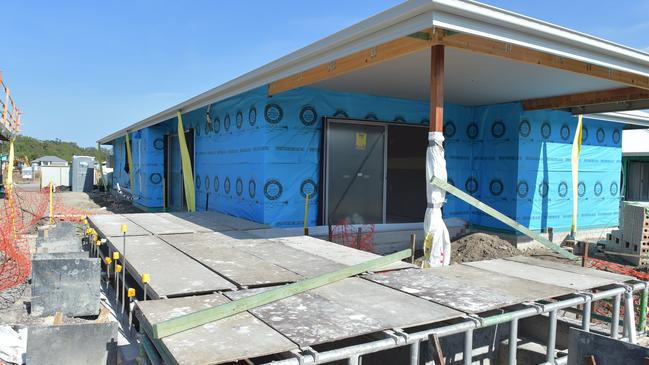Supply at the heart of a fix for housing crisis
State governments are now starting to address the lingering housing crisis, with experts arguing more must be done to tackle impediments to supply.

Federal and state governments must hit laggard councils that are shirking their responsibilities to deliver the required number of new homes to avoid the housing crisis becoming entrenched, according to key property players.
Housing supply has been added to state government agendas across the nation as the rental crisis flares and affordability hits record lows as interest rates lift. There is also little light from the under-pressure construction industry as building approvals fall.
Housing summits, social housing funding and mandatory new dwelling targets are the latest attempts by state governments to stimulate construction of new and affordable dwellings, while the Albanese government has also committed to a National Housing Affordability and Supply Council to help streamline supply.
This burst of vigour in addressing the issue comes as building approvals have started to slump as the last of the pandemic stimulus is worked through, and rising interest rates and construction costs make delivering new properties expensive for developers and consumers.
PropTrack group director of economic research Cameron Kusher said it was essential that all levels of government come together.

One consideration for the federal government to address would be to adopt one of the recommendations from the Morrison government’s affordability inquiry that would limit funding to councils not meeting their targets.
“A lot of local governments are not hitting their targets,” Mr Kusher said. “If we look at Sydney, the affluent areas get very little new supply, and all the new housing supply, even high-density housing supply, is pushed out to the less affluent areas.
“We need to find ways to get more housing built in those areas closer to the city, that is more affluent. Obviously, politically, for local governments, it’s not popular to do that.”
The Morrison government’s HomeBuilder pandemic stimulus package brought forward demand for new housing by giving incentives to buyers with a $25,000 cash injection towards their property. At the same time, construction costs began to surge as a result of materials and skilled labour being in short supply.
The balance of homes greenlit under the package is expected to be completed by the end of the year, according to the Housing Industry Association. But the record amount of work is unlikely to meet the number of dwellings required to keep up with household formation even without migration.
In February, the National Housing Finance and Investment Corporation’s State of the Nation’s Housing report projected that supply would remain strong and see about 550,000 new dwellings after demolitions over the three years to 2023-24, though it would leave a shortfall of about 136,000.
But the government body’s head of research, Hugh Hartigan, believes their predictions for completions will come out lower due to the changing market dynamics.
“Rapidly rising interest rates and the strongest building cost inflation in decades are providing substantial headwinds for the future supply pipeline,” Mr Hartigan said.

The rental crisis that emerged over the past two years and caused vacancy rates to shrink to near-two-decade lows of 1 per cent has put pressure on state governments to react, which Centre for Independent Studies chief economist Peter Tulip said was their responsibility. “Despite what some premiers say, that is within the power of every state government, and it’s their responsibility,” he said
The Palaszczuk government has just held a roundtable to address the state’s housing shortage ahead of a summit next month, following similar moves by South Australia Premier Peter Malinauskas in August. In NSW, new five, 10 and 20-year housing targets will be made mandatory for councils from Newcastle to Wollongong under the new Greater Cities Commission.
Various states, including Western Australia, have also pledged funds towards social and affordable housing delivery.
Earlier this year, the Victorian government sidelined plans for a levy on all newly built developments with three or more dwellings or lot subdivisions, which would have required developers to hand over 1.75 per cent of the expected project value to a social housing growth fund from July 2024.
Mr Tulip noted that housing targets like those in NSW needed to be ambitious and enforced.
“The Greater Cities Commission do a plan every few years which sets targets for local councils – those targets need to be higher, and they need to be enforced,” he said.
“At the moment, there are very weak penalties for local councils that don’t meet the targets that are assigned, and in fact the majority of councils have not been meeting their targets.”

Last week, the Real Estate Institute of Australia released its Housing Affordability Report, finding first-home buyers and renters faced deteriorating conditions in the June quarter. A higher percentage of income was needed to service a mortgage or weekly rent, with national president Hayden Groves expecting the situation to worsen unless supply constraints were urgently addressed by state and federal governments.
“Unfortunately, government responses at the state level have been to introduce legislation that is punitive, that is, they’ve introduced a new land tax,” Mr Groves said.
“There’s been a significant pendulum swing in those legislative frameworks in favour of tenants and, as a result, you’ve seen more and more investors leave the market or will not enter it in the first place, and all of that impacts supply.”

Property Council of Australia chief executive Ken Morrison agreed, insisting a “myriad” of approaches were needed to tackle the supply problem head on, otherwise the affordability crisis could deepen.
“I think there’ll be a lot of political pressure around the rising nature of rents in a coming couple of years,” Mr Morrison said.
“Overlay that with this broader housing supply piece and clearly we need to arrest that housing supply deficit.” Otherwise, there was a risk of “housing suppliers starting to jack up house prices, again, artificially”.
With so much consumer demand brought forward during the pandemic, many commentators expect a lull in market demand over the coming year, bringing building approvals down from the record highs achieved early last year.
Mr Kusher said buyers may also start showing a preference for established homes due to currently falling prices as the cost of new builds were unlikely to budge anytime soon.
“A lot of developers simply can’t go ahead with projects or they’re going back to the buyers and saying, ‘we need you to tip in X amount for this project to go ahead; otherwise, we’ll have to put the kybosh on it’,” Mr Kusher said.








To join the conversation, please log in. Don't have an account? Register
Join the conversation, you are commenting as Logout